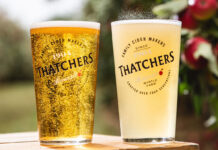Major names account for lion’s share of sales, but cellar and glassware crucial

WITH craft beer continuing to hog the headlines it’s easy to forget that the more mainstream keg brands continue to account for the vast majority of on-trade ale volumes.
Brewers have told SLTN that, while keg ale, in line with the total beer category, has seen sales figures fall in recent years, the category remains a valuable proposition to licensees.
“Keg is the biggest segment of the ale category in Scotland, accounting for 65% of sales value,” said Ian Risby, divisional manager for McEwan’s Beer Company, a division of Wells and Young’s.
“Although we have seen sales in the category fall year-on-year, the last few months we have seen reinvigoration with sales up by 6%.”
And while craft beer may satisfy consumers’ desire to experiment with new tastes and flavours, the big name brands say they have built customer loyalty over years in the trade.
Dom South, head of marketing for Greene King Brewing and Brands, parent company of Belhaven, said keg ale drinkers are “a surprisingly broad group”.
There is a halo effect from craft and it’s bringing new drinkers from other categories.
“They range from younger beer explorers to older drinkers who prefer the quality and consistency offered by ‘a pint of the usual’,” said South.
And far from impacting on sales of keg ale, the rise of craft beer has helped to grow the ale category overall, said South.
“There is a halo effect from craft and the great news about this category is it is bringing in new drinkers from lager and other alcoholic drinks who want to try something different and with more taste,” he said.
As with any on-trade drinks category, the quality of serve is essential to the success of keg ales, and South stressed the importance of good cellar management to providing customers with the perfect pint.
“Quality starts in the cellar,” he said.
“Good cellar management is crucial in running a successful bar as it determines the quality of the ale you serve. Factors such as the temperature of your cellar, regularly cleaned lines, and well maintained cooling equipment are vital to pouring a great pint.
“However, upstairs in the bar, cleanliness of dispense equipment and cool, clean, branded glassware are all important to ensure that you serve the perfect pint of ale to your customers.”
This was echoed by Diageo, parent company of Guinness.
A spokeswoman for the company, which runs its own accreditation scheme for serving Guinness, said dispense equipment “needs to be maintained on a regular basis to ensure consistent temperature specifications”.
In the case of Guinness, the optimum storage temperature was said to be between 10°C and 12°C, with it taking around 24 hours to chill an 11-gallon keg down to that level.
Lines should be cleaned every seven days, said the spokeswoman, with the nozzles soaked in warm water at the end of every trading period.
And she also stressed the importance of using the correct glassware, with licensees advised to ensure they have enough branded glasses for their busiest periods, and to allow glasses the time to dry naturally on racks or plastic matting.
Paying close attention to dispense will allow publicans to produce “consistent, great-looking” pints every time, said the spokeswoman.
























